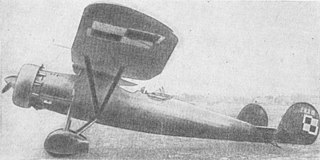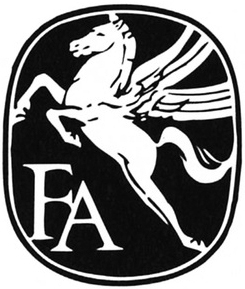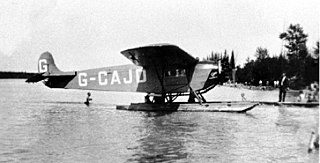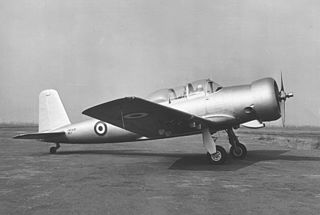
The Lockheed Model 9 Orion is a single-engined passenger aircraft built in 1931 for commercial airlines. It was the first airliner to have retractable landing gear and was faster than any military aircraft of that time. Designed by Richard A. von Hake, it was the last wooden monoplane design produced by the Lockheed Aircraft Corporation.

The de Havilland Canada DHC-3 Otter is a single-engined, high-wing, propeller-driven, short take-off and landing (STOL) aircraft developed by de Havilland Canada. It was conceived to be capable of performing the same roles as the earlier and highly successful Beaver, including as a bush plane, but is overall a larger aircraft.

The de Havilland Canada DHC-2 Beaver is a single-engined high-wing propeller-driven short takeoff and landing (STOL) aircraft developed and manufactured by de Havilland Canada. It has been primarily operated as a bush plane and has been used for a wide variety of utility roles, such as cargo and passenger hauling, aerial application, and civil aviation duties.

A bush airplane is a general aviation aircraft used to provide both scheduled and unscheduled passenger and flight services to remote, undeveloped areas, such as the Canadian north or bush, Alaskan tundra, the African bush, or savanna, Amazon rainforest or the Australian Outback. They are used where ground transportation infrastructure is inadequate or does not exist.

The Howard DGA-15 was a single-engine civil aircraft produced in the United States by the Howard Aircraft Corporation from 1939 to 1944. After the United States' entry into World War II, it was built in large numbers for the United States Navy and also served various roles in the United States Army Air Forces.

The Noorduyn Norseman, also known as the C-64 Norseman, is a Canadian single-engine bush plane designed to operate from unimproved surfaces. Distinctive stubby landing gear protrusions from the lower fuselage make it easily recognizable.

The Bristol Type 173 was a British twin-engine, tandem rotor transport helicopter built by the Bristol Aeroplane Company. It was designed by Raoul Hafner as a civil transport helicopter but evoked interest from the military. It did not enter production but was developed into the Bristol Belvedere which was operated by the Royal Air Force from 1961 to 1969.

The DH.83 Fox Moth was a successful small biplane passenger aircraft from the 1930s powered by a single de Havilland Gipsy Major I inline inverted engine, manufactured by the de Havilland Aircraft Company.

The PWS-19 was a Polish reconnaissance and bomber plane prototype of the 1930s, constructed in the PWS.

Fairchild Aircraft Ltd. was an aircraft manufacturer active at Longueuil, Quebec, Canada in the period 1920–50. It served as a subsidiary of the Fairchild Aircraft company of the United States.

The Fokker Universal was the first aircraft built in the United States that was based on the designs of Dutch-born Anthony Fokker, who had designed aircraft for the Germans during World War I. About half of the 44 Universals that were built between 1926 and 1931 in the United States were used in Canada. Among the famous pilots who flew the Fokker Universal were Punch Dickins and Walter Gilbert.

The Fairchild 71 was an American high-wing monoplane passenger and cargo aircraft built by Fairchild Aircraft and later built in Canada by Fairchild Aircraft Ltd. (Canada) for both military and civilian use as a rugged bush plane.

The Fiat G.49 was an Italian two-seat basic trainer designed by Giuseppe Gabrielli and built by Fiat.

The Fairchild FC-1 and its derivatives were a family of light, single-engine, high-wing utility monoplanes produced in the United States in the 1920s and 1930s. The aircraft was originally designed to provide a camera platform for Sherman Fairchild's aerial photography and survey business, Fairchild Aerial Surveys.

The Fairchild 82 and the 34-42 Niska were a family of utility aircraft produced in Canada in the mid-1930s, based on designs by Fairchild Aircraft Ltd. (Canada)'s parent company in the United States.

The Fairchild Super 71 was a Canadian parasol-mounted high-wing monoplane cargo aircraft built by Fairchild Aircraft Ltd. (Canada). The Super 71 was an entirely new design that was one of the first purpose-built civilian bush planes for use in remote and northern locales in Canada.

The Fairchild 45-80 Sekani was a Canadian twin-engined transport aircraft developed in Canada in the late 1930s. Although the 45-80 was the largest bush plane developed by Fairchild, its poor performance doomed the project, and nearly the company.

The Fokker Super Universal was an airliner produced in the United States in the late 1920s, an enlarged and improved version of the Fokker Universal, fitted with cantilever wings and an enclosed cockpit. It was subsequently also manufactured under license in Canada, and in Japan as the Nakajima-Fokker Super Universal and for the IJAAF as the Nakajima Ki-6 and later in the puppet state of Manchukuo as the Manshū Super Universal.

The Fairchild 100 Pilgrim is an American single-engined high-wing monoplane transport, and was one of a series of single-engine utility transports built by Fairchild Aircraft.
The Curtiss-Reid Courier was designed in Canada in 1931 as a specialist, non-passenger carrying, mailplane capable of maintaining services in Canada's hard winters. The 1930s depression led to the end of government subsidised airmail contracts and only one prototype flew. It was lost in 1933 during preparations for a private, long distance flight.




















